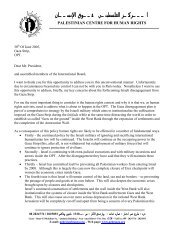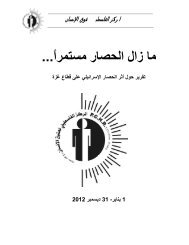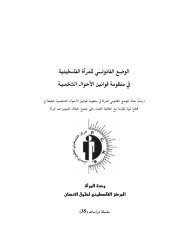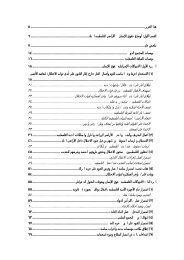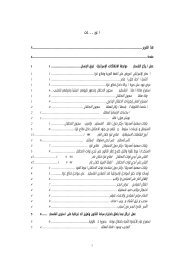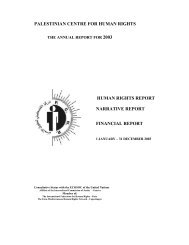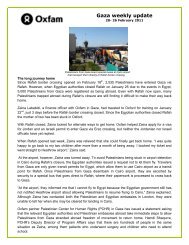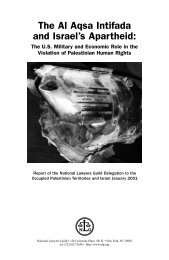Annual Report - Palestinian Center for Human Rights
Annual Report - Palestinian Center for Human Rights
Annual Report - Palestinian Center for Human Rights
You also want an ePaper? Increase the reach of your titles
YUMPU automatically turns print PDFs into web optimized ePapers that Google loves.
West Bank and the Gaza Strip are invited to participate in free and direct elections to<br />
elect members of the <strong>Palestinian</strong> Legislative Council on Sunday, 17 July 2005.”<br />
PCHR welcomed this step and considered it an important development in the<br />
<strong>Palestinian</strong> democratic re<strong>for</strong>m process, especially after the Presidential election of<br />
January 2005, the first stage of local council elections and the scheduling of the<br />
remaining stages of local council elections had taken place. However, the Centre did<br />
become concerned about the feasibility of holding the PLC elections on the planned<br />
date, in light of the PLC’s reluctance to pass the new general elections law just 3<br />
months be<strong>for</strong>e the elections were due to be held. The passing of this law was a<br />
precondition in order to allow the CEC to start preparations <strong>for</strong> the elections. 39<br />
The proposed elections law contained significant changes and amendments to the<br />
<strong>Palestinian</strong> elections system that had been operating under the General Elections Law<br />
issued by a Presidential Decree back in December 1995 (be<strong>for</strong>e the inception of the<br />
PLC in March 1996). At the <strong>for</strong>efront of these changes was the adoption of a mixed<br />
system, where two-thirds of the PLC members would be elected by a majority [firstpast<br />
the post] system and one-third by a proportional system.<br />
At the time, PCHR considered the mixed system to be a positive change to the<br />
<strong>Palestinian</strong> electoral system. The Centre considered the proposed system more<br />
representative of <strong>Palestinian</strong> plurality. However, the Centre and other civil society<br />
organizations requested additional amendments. They requested that at least half the<br />
PLC members should be elected by the proportional system, in line with<br />
understandings reached between the PNA and <strong>Palestinian</strong> parties in Cairo in March<br />
2005.<br />
On 3 June 2005, President Mahmoud Abbas issued a Presidential Decree canceling<br />
the PLC elections on 17 July 2005 and giving provision <strong>for</strong> a new date <strong>for</strong> elections to<br />
be set, once all legal preparations and all national consultations had been completed.<br />
PCHR expressed concern at delaying the PLC elections without setting a new date<br />
immediately. This concern was expressed, while also fully understanding that the<br />
month and a half remaining be<strong>for</strong>e the scheduled election date would be reached, was<br />
insufficient time to allow all preparations to be conducted, even if the elections law<br />
was passed immediately. Although the delay was attributed to legal issues and to the<br />
implementation of the Israeli disengagement plan from the Gaza Strip, the internal<br />
problems within the ruling Fatah party also played an important role in this decision.<br />
On 13 August 2005, Law #9 of 2005 relating to elections was passed. It was<br />
published in the <strong>Palestinian</strong> Legal Journal on 18 August 2005. Article 3.1 of the new<br />
law adopted the mixed system, with 50% of PLC members elected through a majority<br />
system and the other 50% through a proportional system. Article 3.2 raised the<br />
number of PLC members to 132. The 66 members elected through the majority<br />
system were to be distributed over 16 electoral districts, each getting a quota in<br />
accordance with its population, with a minimum of one seat. A Presidential Decree<br />
reserved six seats <strong>for</strong> Christians. The other 66 members were to be elected through<br />
proportional representation and considered the OPT as one electoral district.<br />
39 For more in<strong>for</strong>mation, refer to PCHR’s press release dated 10 April 2005.<br />
55




